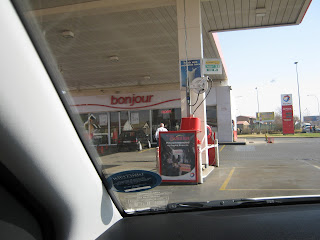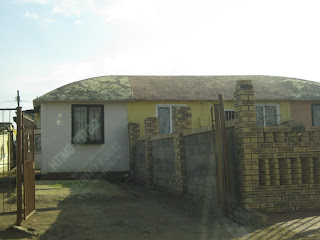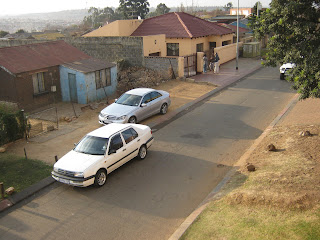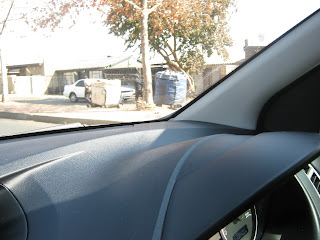 |
| Our first glimpses of the Johannesburg Temple. |
 |
| High textured ceilings, graceful arches and beautiful architecture made a lovely setting The origninal house had this wrap-around feature that now provides window seating for most guests. |
 |
| But, then I said.. "Nooo.. look, you did not smile. You must smile." She thought that was pretty funny! |
 |
| Getting ready to dig in to a peppermint, chocolate something or other. |
 |
| Oh yes, I forgot the caramel and nuts! Isn't this a nice presentation? |
This cleaning woman's uniform included the quaint, old-fashioned cap.
In Kinshasa, most police are on foot with a few on motorcycles.
In Jo'burg, police cars are everywhere.
Look at the following picture for a closer view of this one...
How much does a policeman have to make for THIS to be worth it?
My handsome husband... he cleans up nice!
 Delicious prawn meal.. somehow, unlike those caterpillars of yore, these eyes didn't bother me. But, next to me was Sister Curtis, who is NOT from Florida and had more trouble with it.  |
| Dominic Tshabalala and Thoba Karl-Halla delighted all the couples (and the other patrons, too) with an impromptu song & dance entertainment. Both of them have incredible personal stories. Thoba's mother was a kind, wise & wonderful woman. She was also a heroine in the Apartheid underground resistance, (a fact which the children did not know until after their mother's death). Thoba Karl-Halla's Story Dominic is one of the most likable and humble people you could meet. His early life could easily have turned him into a different person. Dominic Tshabalala's Story |
The Roberts on the left are the Area Public Affairs couple.
When asked by Elder Webb (right) "Did any good thing ever came out of Idaho?",
Elder Robert's responded, "Of course! I-15!"
They helped organize the trip of BYU's Young Ambassadors to So. Africa.
This was so much fun... those who knew how sang "Happy Birthday!" in Zulu.
A sweet young mother asked if she could take a picture of us
just after we'd come out of the temple. A thoughtful gesture.
Does THIS not tell a visual story? I had no idea how large Africa is
(& probably most others don't either).
Here is Thoba on the temple grounds. She volunteered to give us a tour of Soweto.
 |
| She insisted on taking our picture, too. |
I couldn't resist taking this.. one of the original four in this flower flew away.
A lovely waterfall setting on the temple grounds. Look at this unusual palm.
This was my favorite spot. It''s so lush, despite the fact that it's "winter" here.
You can't get the full perspective of how big this tree is, but it was beautiful.
This, by contrast, looks quite ugly NOW... but is completely red in season.
We approached Nelson Mandela's newer home in Johannesburg.
This is the side wall.

The front wall had a guard house,
but Mandela is currently living in the simple village where he was born.
Another picture of us, just to prove we were there.
This was the day before Mandela's 94th birthday which was celebrated extensively.
"TATA" is Mandela's affectionate nickname.
Anyone can paint a stone and leave a message. I wish we'd been prepared to do that.
The more I've learned about Nelson Mandela, the more I know he is a great man.
A few years ago, I so loved the poem "Invictus" that I memorized it.
Then, the movie by that name came along. It demonstrates his courageous life so well.
Tall minarets help this huge mosque to be seen from far away.
It will soon be completed and will be able to be toured by the public for a fee.
This is the first half of a wall surrounding a wealthy home.
The second half goes far beyond.
In wealthy Upper Houghton, these large, walled estates are common.
A beautiful view, even for "winter".
Again, Thoba insisted we get in a picture.
In this view, you can barely see the mosque and well-traveled Oxford Rd.
From the wealthiest area of Johannesburg to the poorest.
The "inner city" of this great city is dirty and unkempt, like many others around the world.
This park has become a place for loiterers and drug deals.
Many "Bed & Breakfast" businesses surrounding the park
are actually "fronts" for drug operations.
 |
| Vendors for fruits, vegetables, etc. set up on the streets. |
 |
| A nice view of a better part of the city. The tower is both a Post Office and Communications tower. |
Thoba pointed out to us that these words are in four languages,
Zulu, Sutu, Afrikaan & Swahili
The woman whose sculpted this (and others in the city) said that she did so from a dream.
Looks more like a nightmare to me.
A statue symbolizing the fight against Apartheid.
The Afrikaan version of our name.
Another view of Johannesburg (as you can see, Coca Cola is world wide)
I have forgotten the meaning of this frieze on an old building.
Walter Sisulu was another leader in the ANC.

We took a moment to go in with Thoba, who had to deliver something to them.
She is doing an "outreach" to the ANC.
Unfortunately, my pictures inside didn't turn out.
Interestingly, the cars park in the middle on this street.
Buses with super high doors load & unload at stations (right)
The police are a very visible presence in Johannesburg.
This is an indication of the large Muslim population in So. Africa.
Different products and not as many vendors in the traffic, but reminded me of Kinshasa.
Apparently, Walmart is also universal.
Look at the vast length of this mall and the amount of space devoted to liquor.
Standing by the van is one of the two Chinese "middle men".
 |
| One of many Chinese shopping mall signs. |
 |
| Advertisements on the highways for another Chinese shopping mall. |
 |
| CAM stands for Chinese Auto Mall |
 |
| Many of the Chinese malls were gigantic. |
The large stadium where the World Cup was played
and the Voo Voo Zelas made so much noise.
 |
| Just outside Jo'burg, you can see the gold mining operations. |
 |
| Those who operate the gold mines are "re-mining" in many places. Newer, more efficient and effective machines can pull out more gold from previous discarded sand. |
 |
| A small example of the red topped, beautiful & usually much larger Aloe Vera. |
 |
| Monument to Voo Voo Zelas |
 |
| Our first sight of Soweto was surprisingly neat and clean. |
 |
| These were and are the homes of the better off Africans in Soweto |
 |
| I saw three or four people from this tribe over several days, but only managed to get this one picture. |
 |
| The houses are small, so if there is a funeral or wedding the room for guests is expanded wiith tents. Of course, these cover the entire residential street, which is illegal, but they do it anyway. |
 |
| Always interesting to see an American company abroad. Security is BIG business in So. Africa. |
 |
| These are some of the poorer houses of Soweto. |
 |
| The neater homes to the left of middle were built by the government for the really poor. The really poor, not completely following the plan, remain in their shacks and rent the nicer houses. |
 |
| Some interesting artwork on these.. including an oval w/ the Virgin Mary in the middle. |
 |
| Never did find out why this station had a French greeting on it. |
 |
| A location where homes were burned down in Soweto. |
 |
| For my Florida family & friends... Makes me want to shout... "I'm going to Disneyworld!" |
 |
| A wall with Apartheid heroes painted on it. |
 |
| A little closer look shows Mandela as the winner of the Nobel Peace Prize and also as the 1st black president of South Africa. |
 |
| These small houses were built by the government with only one door to enter or exit from. It only had one bedroom, no matter how many people & also featured a solid one piece concrete roof. |
 |
| The entrance to Regina-Mundi Church, a place where hundreds sought refuge & sanctuary from police. It didn't work as was attested to by many bullet holes which we were shown. |
 |
| "Danny" was our paid tour guide for this and pointed out many historic locations in the Church. |
 |
| Police troops stormed the Church and did much damage. |
 |
| If you can read it, this is a brief history of the Soweto story. |
 |
| I could have taken a picture of myself standing on the spots where Desmond Tutu or Michele Obama stood. I chose to do it where Nelson Mandela stood to address the people. |
 |
| The upstairs of the Church has a collection of black & white pictures (symbolic?) They cover the history of Soweto from start to finish. People have left touching messages on the walls. |
 |
| The sign in the back says, "We are not fighting, we are mourning." Funeral participants were strictly limited as was the time taken. If a funeral went beyond what police wanted, they rushed in and hauled people away. |
 |
| Desmond Tutu speaking in the church. |
 |
| This picture reminded me of some from the states in the 60's. |
 |
| A happy day as Mandela cast the first ballot. |
 |
| This picture title says, "Roles are Reversed". It shows a white sales lady helping a black customer. |
 |
| Nelson Mandela, Desmond Tutu and Steve Biko with others less well known. |
 |
| The most famous street in Soweto.. Vilakazi St. |
 |
| It was on this corner that a famous incident took place. The police were coming after people and, in the rush, a young boy fell down. Hector Peterson (Pieterson) Story |
 |
| Looking down Vilakazi Street now (with the gold mines on the horizon), it is peaceful and lovely. |
 |
| This is not the house... just the sign on the fence of Mandela's house. |
 |
| One section held all sorts of pictures and mementos of famous people who had met with Mandela. This is the World Boxing Heavyweight Championship belt given to him by Sugar Ray Robinson. |
 |
| A deserving Nelson Mandela receiving the Nobel Peace Prize. |
 |
| An equally deserving F.W. de Klerk receiving the Nobel Peace Prize jointly with Mandela. It is the only time that the prize has been given to two former adversaries. |
 |
| Just a tender, personal note from Mandela. |
 |
| After the birth of each of their children, Winnie Mandela buried the umbilical cord under this tree. It was considered good luck. |
 |
| When we left the Mandela house, this man began to entertain us. You may have to zoom in to see how impressive his moves were. |
 |
| He made this look easy, but try it. |
 |
| If my arms were TWICE as long, I couldn't do this! |
 |
| It seemed as if he could contort any part of himself. |
 |
| You are looking at his head and back. See how far you can twist. We paid him with what looked like a good amount of Rand coins... but we weren't sure. |
 |
| Stone replicas of the hand signals used in Africa. We often see them used in Kinshasa to communicate. |
 |
| A nice sitting area upstairs. |
 |
| A quaint place to relax and enjoy the company of others or eat at the nearby tables. |
 |
| Across the street was an illegal "bar". Since it is not licensed, the owner & patrons have to be careful. |
 |
| Left over from the Apartheid days... these were found every couple blocks. They lit up the streets so that police could make sure no one was breaking the dusk to dawn curfew  . .I love to see children happily playing. Here, they are skipping a rock ahead of them and then running to it. They seem to be able to find a way to have fun, no matter what their circumstances. Their innocent optimism helps all of us to feel a little bit more of faith and hope in the future. |




























































Well it looks like there was much to enjoy while in Johannesburg. I'm sure you enjoy the food. I know you were posting a lot of pictures so it must be hard to have descriptions, just some things I noticed. Was there a big pink ball on one of the buildings downtown?I thought the wooden sculpture was interesting, not sure what it was though. I have to say that the contortionist was the most amuzing. So are you already back to the jungle? It looks like you enjoyed your quick "vacation" to civilization .Oh and the singing was nice too.
ReplyDeleteand what's with the giant soccer balls?
ReplyDeleteIt's nice to see you eating a meal without worms in it! Looks delicious!
ReplyDeleteJuli..here is the explanation (per Sue) about the soccer balls (which I deleted after you saw it because I couldn't remember the facts related to them): "The soccer balls are from the 2012 World Cup we had here in South Africa ... that was a wonderful time of celebration and brought many people of different races and colour together celebrating. Soccer in South Africa is mainly a sport for blacks while Rugby is mostly for whites ... and the big pink ball on the Post Office tower is also from the same event .. it was just left on after I suppose as a reminder to all."
ReplyDeleteJanice... there was not a bad meal the whole time we were there (almost 2 weeks!) After five months of food-challenges in Kinshasa, it was heavenly to eat and enjoy good meals.
ReplyDelete